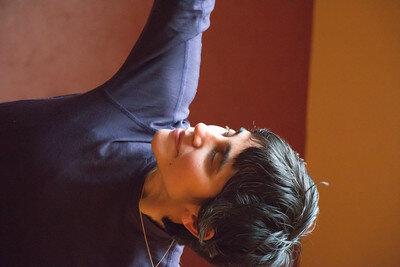Vyana Vayu: Keeping it all Together
We arrive at the fourth of the 5 Prana Vayus. If you are followingthis blog series, you might take a quick read of the first 3 on our blog. If you are not interested, please feel free to skip ahead to our list of events and announcements.
Overall, Vyanu Vayu is the force that holdsall of the parts of the body together and resists disintegration. Whilenot associated particularly with either inhale or exhale, its mundanefunction has to do with proprioception, or our awareness of where we arein the body, and where the body is in space. Vyanu Vayu describes how the body balances and maintains itself through thecentral nervous system, and it is also strongly associated with fascia,or the connective tissue that literally holds the body together. It is Vyanu Vayu that gives us a sense of the body, how we are held together, integrated, and coordinated as a unified whole. As a "force", Vyanu Vayu resists falling apart, both physically and in different emotional aspects of the body. Beyond that, Vyanu Vayu gives us the more subtle experience of being that dissolves theboundaries between individual consciousness and all pervasiveconsciousness. All of the other Vayus play a function in producing thisexperience of Vyanu Vayu, and at the sametime, these Vayus depend on the original presence of Vyana for theirfunction: In this self-sustaining loop of life, Vyana acts as a kind ofbinding of body and soul, through nourishment of body and heart. Yet,paradoxically it's the presence of Vyanu Vayu there to begin with that allows the whole process to take place. WhenVyanu begins to break down—often a failure of one of the other vayus,like the ability to digest your food, or to derive nourishment (Samana Vayu)—healthbegins to fail. At the time of death, all the vayus involute and thevital functions of the mind and senses withdraw into Vyanu Vayu, and Uddana Vayu becomesthe vehicle by which the Pranas leave the body. This consolidation ofthe Prana Vayus at the moment of death explains how the soul is carriedout of the body to be reincarnated for another life. For those of us whodon't believe in reincarnation, this also describes the process ofmeditation. All the energies of the Prana Vayus become consolidated in aclear, central experience that takes you inside and toward the essenceof life, toward the soul itself. It is here, through the experience of Vyanu Vayu,that we have those momentary experiences of all-pervasiveness, ofoneness with everything. While living in the body, it's the process ofmeditation that gives you the experience of your consciousness aspervading not just the body, but as being all-pervasive. This experienceof meditation is how we begin to move from the ordinary experience ofthe embodied self, to the more exalted experience of our boundlessconnection with each other and the world around us.
So, you can certainly experience Vyanu Vayu through the process of meditation. You can also experience it through a broad range of asanas. While Vyanu Vayu permeates the entire body, regulating balance and moving outward fromthe core to the periphery, vyana is particularly active in the limbs,making standing poses a clear vehicle through which to "feel" Vyanu Vayu.Standing poses allow us to connect the various movements of the armsand legs with core strength, which is a key tool for developing focus,mental clarity, and expansion of consciousness. Practiced with skill,standing poses help us cultivate grace and sensitivity, counteringfeelings of weakness and the discombobulation associated with anxietyand alienation.
Next time you are practicing standing poses, spend some time becomingaware of the network of connection that radiates from the core outthrough the limbs, anchoring the strong sense of being in your body, onyour mat, in the space you inhabit. See if you can "feel" this all theway to your outermost layer, your skin. In Savasana, observe how perhapsyour sense of your own boundaries then dissolve as you let go intodeep relaxation.

